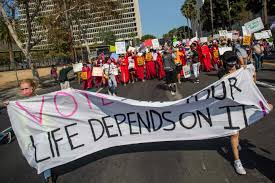
The coming decade of Democratic dominance
By a circuitous route to a predictable destination, the 2020 presidential selection process seems almost certain to end Tuesday with a fumigation election. A presidency that began with dark words about “American carnage” probably will receive what it has earned: repudiation.
In “Three Exhausting Weeks,” a short story in Tom Hanks’s collection “Uncommon Type,” a man has a short, stressful relationship with a hyperactive woman: “Being Anna’s boyfriend was like training to be a Navy SEAL while working full-time in an Amazon fulfillment center in the Oklahoma Panhandle in tornado season.” After the past four years, Americans know the feeling, which is why President Trump’s first and final contribution to the nation’s civic health will be to have motivated a voter turnout rate not seen for more than a century — not since the 73.2 percent of 1900, when President William McKinley for a second time defeated the Democratic populist William Jennings Bryan. The poet Vachel Lindsay (1879-1931) had fun making fun of Bryan’s populism: “Nebraska’s cry went eastward against the dour and / old, / The mean and cold. . . . / Smashing Plymouth Rock, with his boulders from the / West.”
Imagine what fun Lindsay could have had with today’s preeminent populist, who has taken more than $70,000 in tax deductions for hair styling. His style has been his substance. His replacement for Obamacare remains as nonexistent as his $1 trillion infrastructure program. He resembles the politically excitable woman in Philip Roth’s novel “American Pastoral,” whose “opinions were all stimuli: the goal was excitement.”
In defeat, Trump probably will resemble another figure from American fiction — Ring Lardner’s “Alibi Ike,” the baseball player whose talent was for making excuses. Trump will probably say that if not for the pandemic, Americans would have voted their pocketbooks, which would have been bulging because of economic growth, and reelected him. Americans, however, are more complicated and civic-minded than one-dimensional economy voters. But about those pocketbooks:
The 4 percent growth Trump promised as a candidate and the 3 percent he promised as president became, pre-pandemic, 2.5 percent during his first three years, a negligible improvement over the 2.4 percent of the last three Barack Obama years. This growth was partly fueled by increased deficit spending (from 4.4 percent of gross domestic product to 6.3 percent, by the International Monetary Fund’s calculation). Bloomberg Businessweek reports, “In the first three and a half years of Trump’s presidency the U.S. Department of Labor approved 1,996 petitions [for Trade Adjustment Assistance] covering 184,888 jobs shifted overseas. During the equivalent period of President Barack Obama’s second term, 1,811 petitions were approved covering 172,336 workers.” And the Economist says:
“Recent research suggests that Mr. Trump’s tariffs destroyed more American manufacturing jobs than they created, by making imported parts more expensive and prompting other countries to retaliate by targeting American goods. Manufacturing employment barely grew in 2019. At the same time, tariffs are pushing up consumer prices by perhaps 0.5 percent, enough to reduce average real household income by nearly $1,300.”
Demographic arithmetic is also discouraging for Trump. There are more than 5 million fewer members of his core constituency — Whites without college degrees — than there were four years ago. And there are more than 13 million more minority and college-educated White eligible voters than in 2016.
In Ronald Reagan’s 1984 reelection, voters under 30 were a solidly Republican age cohort; 2020, for the fifth consecutive election, it will be the most Democratic. The Atlantic’s Ronald Brownstein believes this year’s “generational backlash” against Trump presages for Republicans a dismal decade during which two large and diverse cohorts — millennials (born between 1981 and 1996) and Generation Z (born between 1997 and 2012) — become, together, the electorate’s largest bloc in an electorate that, says Brownstein, “is beginning its most profound generational transition since the early 1980s,” when baby boomers (born between 1946 and 1964) became the largest bloc. In 2016, Trump won just 36 percent of adults under 30; Obama averaged 63 percent in two elections. Furthermore, this will be the first presidential election in which the number of millennial and Generation Z eligible voters will outnumber eligible baby boomers. Generation Z is 49 percent people of color.
Economic and demographic statistics are not, however, the only ones pertinent to next Tuesday’s probable outcome. Novelist John Updike supplied another: “A healthy male adult bore consumes each year one and a half times his own weight in other people’s patience.” This nation and its patience are exhausted.